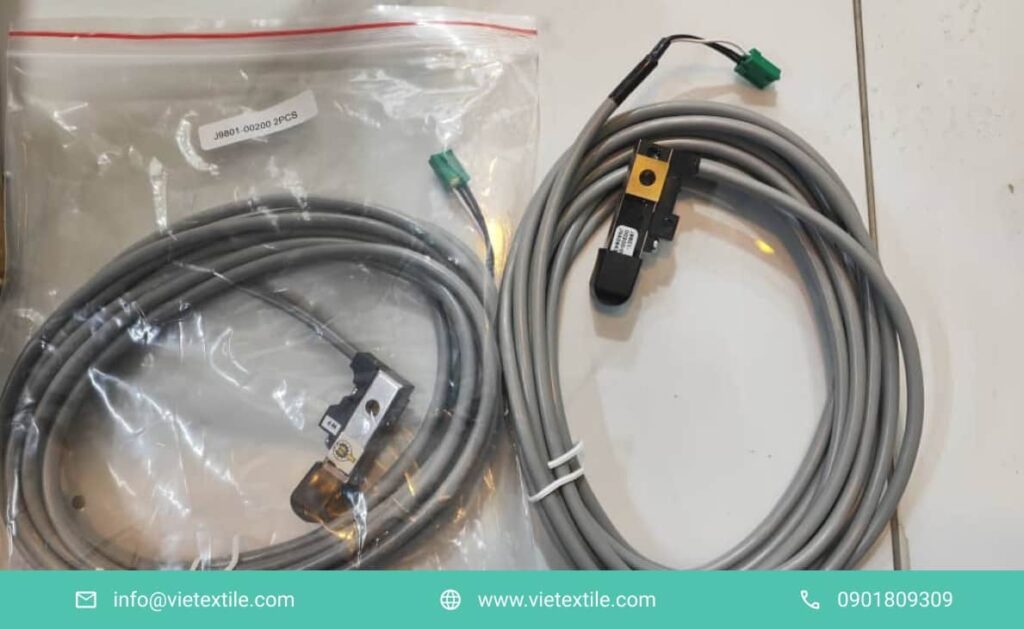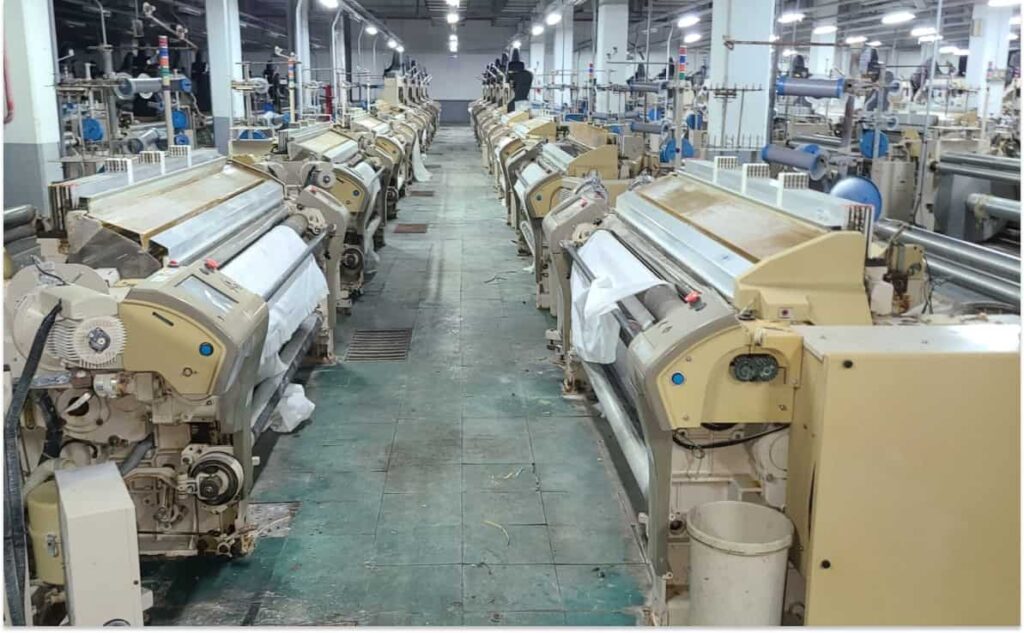Tsudakoma Waterjet looms (most commonly the ZW series) are key workhorses in the production of filament fabrics due to their superior weaving speed and high energy efficiency. However, the principle of weft insertion using extremely high-pressure water subjects the Tsudakoma Waterjet loom components to severe hydraulic and mechanical stress.
Wear and tear on critical parts such as the high-pressure pump, nozzles, and sealing systems (seals/packings) not only reduce productivity but also cause serious weaving defects, directly impacting the quality of the finished fabric. This in-depth article from VieTextile will help you accurately diagnose faults arising from the physical wear of components.
In the high-intensity textile manufacturing environment, the precision of the Tsudakoma Waterjet is the key to success. A weaving cycle demands that the high-pressure pump generates stable pressure, and the nozzle maintains a perfect water stream shape. When the Tsudakoma Waterjet loom components begin to wear, this stability breaks down, leading to a cascade of errors: pressure drops, water stream dispersion, and unstable weft insertion, resulting in easily visible weaving faults like yarn breaks, horizontal streaks (Barre), or mispicks.
Managing wear is not simply about replacing a part when it completely breaks down. An advanced maintenance strategy must be able to diagnose hidden faults, predict the remaining lifespan of the Tsudakoma Waterjet loom components based on Performance Data, and implement Predictive Maintenance. Using non-genuine or poor-quality spare parts for replacement only accelerates the wear rate and shortens the lifespan of other related components.
We will delve into the 7 most common types of faults, from hydraulic failures (Nozzle, Pump) to mechanical failures (Cutter, Sley), and provide technical solutions to fix them, ensuring your Tsudakoma Waterjet loom always maintains its highest operational efficiency.

1. Overview of Basic Wear on Tsudakoma Waterjet Loom Components
Nội dung tóm tắt
ToggleWear on a Waterjet loom is not just physical deterioration but also functional degradation due to high water pressure and high speed.
1.1. Hydraulic Wear (Cavitation & Erosion)
This is the characteristic form of wear on Waterjet looms, occurring primarily on the pump and nozzle.
- Cavitation: When water passes through areas of rapid velocity change (such as inside the pump or nozzle), local pressure drops suddenly, creating vapor bubbles. When these bubbles collapse, they generate strong shockwaves, causing pitting on the metal surface, especially on the pump piston and nozzle wall.
- Erosion: This is gradual wear caused by solid particles (sediments, minerals) in the water impacting the surface of the Tsudakoma Waterjet loom components, altering the nozzle shape and piston clearance.
1.2. Mechanical Wear Due to High-Speed Friction
Moving parts (Sley, Cutter) are subjected to continuous friction, leading to increased clearance and loss of precision.
- Cutter Blade and Tuck-in Mechanism: Wear reduces sharpness and changes clearance, causing selvage defects.
- Bearings and Main Shaft: Wear due to heavy mechanical load causes vibration, noise, and mechanical misalignment.
1.3. Electronic Wear (Solenoid & Sensor)
Electronic components degrade due to high temperature, humidity, and electrochemical corrosion from water.
- Solenoid Valves: Coils become short-circuited or corroded, reducing reaction speed and causing timing errors in water jetting.
- Sensors: Damage to the optical surface or corrosion of connection pins leads to false error signals.
2. Hydraulic System Failure – The Cause of the Most Severe Weaving Faults
The high-pressure water supply system is where most faults originate. Wear of the Tsudakoma Waterjet loom components in this system leads to fabric quality defects and reduced pump lifespan.
2.1. Main Nozzle and Sub Nozzle
The nozzle’s job is to convert pressure into kinetic energy of the water stream.
2.1.1. Common Fault: Reduced Jet Velocity and Yarn Breakage
- Wear: The nozzle bore is eroded or cavitated, increasing the bore diameter.
- Consequence: The increased bore diameter reduces the pressure and speed of the water jet. The jet disperses, losing its ability to carry the weft yarn across the weaving width quickly. This leads to:
- Machine reporting Weft Breakage because the yarn does not reach the destination in time.
- Increased load on the pump to compensate for pressure loss.
2.1.2. Common Fault: “Water Spot/Streaks” Error
- Wear: Contaminants or erosion alter the shape of the internal nozzle O-ring seat.
- Consequence: The nozzle leaks small water droplets or sprays an uneven water stream, causing repeated water spots or vertical streaks on the fabric. This is a severe quality defect, requiring the replacement of the entire Tsudakoma Waterjet loom component—the nozzle assembly.
2.2. High-Pressure Pump
The high-pressure pump, especially sealing components like seals and the Piston/Plunger, is the component subjected to the highest hydraulic load.
2.2.1. Common Fault: System Pressure Drop
- Wear: The piston seals and packing wear due to friction and cavitation, causing water to leak backward.
- Consequence: The pump cannot maintain the set pressure (e.g., 15 bar} to 10 bar), resulting in poor weft insertion performance and inability to reach maximum weaving speed. The technician must increase the input pressure, which increases energy consumption.
2.2.2. Common Fault: Catastrophic Mechanical Failure
- Wear: The Piston/Plunger is deeply scratched or unevenly worn due to contaminants in the water.
- Consequence: Causes pump seizing, damaging related drive components (crankshaft), leading to catastrophic downtime and extremely high repair costs. Periodic replacement of this Tsudakoma Waterjet loom component’s seal/packing kit is crucial to protect the Piston.
3. Faults Due to Mechanical Drive and Yarn Wear
Mechanical wear reduces timing precision and yarn cutting quality.
3.1. Weft Cutter Assembly
The yarn cutting mechanism determines the quality of the selvage.
3.1.1. Common Fault: Weft Fraying and Selvage Tuck-in Error
- Wear: The Cutter Blade becomes dull or chipped.
- Consequence: The weft yarn is not cut cleanly but is stretched or frayed, creating a ragged selvage. This causes serious faults at the Tuck-in Device and reduces the aesthetic quality of the finished fabric.
- Diagnosis: Visually inspect the cutter blade and check the clearance between the fixed and moving blades. Replace this Tsudakoma Waterjet loom component—the cutter blade—at the first sign of dullness.
3.1.2. Common Fault: Tuck-in Device Damage
- Wear: The Grippers of the Tuck-in mechanism are worn or have loose joints.
- Consequence: The grippers cannot securely hold the weft yarn end, leading to a selvage fault where the yarn end is not tucked into the correct position, causing holes in the fabric edge.
3.2. Sley/Reed Drive System
The Sley is subjected to continuous impact when pushing the weft yarn into the fell.
3.2.1. Common Fault: Barre Due to Vibration
- Wear: The Bearings or brass bushes of the Sley shaft are worn, creating backlash greater than the allowable limit.
- Consequence: The Sley movement is no longer smooth and precise, causing minor vibrations during beating-up. This vibration leads to uneven weft density distribution, creating the Barre fault on the fabric.
4. Electronic and Sensor Component Failure Due to Humid Environment

The water-saturated working environment causes rapid corrosion of the electronic Tsudakoma Waterjet loom components.
4.1. Weft Sensor
This sensor detects whether the weft yarn has reached its destination.
4.1.1. Common Fault: False Stop
- Wear: The optical sensor surface is cloudy due to scratches or deposits of lime/minerals from the water. Or the connector pins are corroded due to humidity.
- Consequence: The sensor fails to accurately detect the weft yarn signal, leading to the machine reporting a yarn break (False Stop) and unnecessary downtime.
4.1.2. Common Fault: Missed Stop
- Wear: The internal electronic circuit of the sensor fails randomly due to excessive humidity or high temperature.
- Consequence: The machine does not stop when the weft yarn is actually broken, leading to a prolonged Mispick fault across multiple weaving cycles, severely damaging the fabric.
4.2. Water Solenoid Valves
The Solenoid valve controls the timing and flow of water to the nozzle.
4.2.1. Common Fault: Hydraulic Injection Timing Deviation
- Wear: The internal spring fatigues or the Solenoid coil overheats, causing the valve’s Response Time to slow down.
- Consequence: The valve opens/closes slower than the signal from the main control board. This causes a deviation in the actual Weft Insertion Angle, leading to unstable weft tension and increased yarn breakage rates. Replacement of this critical Tsudakoma Waterjet loom component is highly sensitive.
5. Fault Diagnosis Strategy from Tsudakoma Component Wear
Accurate diagnosis requires a combination of fabric fault analysis and physical/technical inspection.
5.1. Fabric Fault Analysis for Hydraulic Wear
| Observed Fabric Fault | Potential Wear Root Cause | Inspection and Solution |
| Weft breaks concentrated near the selvage | Main nozzle bore worn, sudden pressure drop | Measure nozzle head pressure, replace the Nozzle. |
| Uneven dark/light horizontal streaks (Barre) | Pump seal worn, system pressure fluctuates | Check for seal leaks, replace the seal kit and Piston. |
| Repeated Water Streaks | Localized nozzle surface wear or nozzle seal leak | Replace the Tsudakoma Waterjet loom component’s nozzle seal or the complete nozzle assembly. |
| Fabric Edge Contraction/Puckering | Dull cutter blade, weak tuck-in mechanism due to wear | Check cutter blade sharpness and the holding power of the Tuck-in grippers. |
5.2. Electronic and Mechanical Fault Analysis
- Bearing/Bushing Faults: Use a Vibration Meter to determine the wear level of the main shaft bearings. High vibration amplitude signals the need for replacement.
- Solenoid Valve Faults: Use a frequency/time meter or Oscilloscope to check the signal delay of the valve compared to the control signal from the PCB. A delay exceeding 5 ms can cause weaving defects.
6. Proper Technical Replacement Procedure for Worn Components

Replacement of Tsudakoma Waterjet loom components must strictly adhere to OEM standards to avoid damaging other related parts.
6.1. High-Pressure Pump Seals Replacement
- Absolute Power Off (LOTO): Disconnect power and release all water pressure from the system.
- Use Specialized Tools: Only use tools designed for seal removal and installation, avoiding scratching the Piston/Plunger.
- Precise Lubrication: Apply a thin layer of specialized lubricant (usually silicone grease or glycerin) to the new seals to reduce initial friction.
- Leak Check: After installation, check for leaks at low pressure before returning the machine to high-speed production.
6.2. Nozzle Assembly Replacement
- Absolute Cleanliness: Before installing the new nozzle, absolutely clean the nozzle chamber to remove contaminants. Small debris can tear the O-ring of the new nozzle.
- Torque Tightening: Use a Torque Wrench to tighten the nozzle to the specified value (typically 10 Nm to 15 Nm). Overtightening will deform the nozzle housing and damage the seal.
6.3. Electronic Component Replacement (Sensor/Solenoid)
- Check IP Rating: Ensure the new Tsudakoma Waterjet loom component has an IP (Ingress Protection) rating suitable for the humid Waterjet environment.
- Use Anti-Moisture Sealant: Use a protective coating (Conformal Coating) for sensitive electronic connection points, especially cable connectors.
7. VieTextile Supplies Genuine Tsudakoma Waterjet Loom Components
VieTextile is committed to providing genuine, OEM-standard Tsudakoma Waterjet loom components, helping factories completely fix wear faults and optimize weaving performance.
7.1. Commitment to High Hydraulic Material Quality
We focus on specialized material quality for Tsudakoma’s hydraulic environment:
- Nozzles: Use Ceramic or Tungsten Carbide materials with the highest resistance to erosion and cavitation.
- Seals/Packings: Provide seal kits made of composite Polymer materials that withstand high pressure and temperature, ensuring no leakage and extended pump life.
7.2. Technical Consulting Service for Fault Diagnosis
VieTextile’s technical team has deep expertise in diagnosing faults caused by wear in Tsudakoma Waterjet loom components. We not only supply spare parts but also support with:
- Analyzing error data from the machine screen (Error Log).
- Measuring actual pressure and weft insertion timing.
- Consulting on Preventive Replacement strategies for components with a limited lifespan.
7.3. Absolute Compatibility Guarantee for ZW Series
We provide a complete range of components for the ZW series (ZW408, ZW8100, etc.), ensuring parts are 100% compatible with the OEM code. This compatibility is the decisive factor for your loom to operate stably at maximum speed without abnormal weaving faults caused by poor-quality components.
8. Frequently Asked Questions about Tsudakoma Waterjet Loom Components (FAQ)
This section addresses the most common questions related to Tsudakoma Waterjet loom components and wear issues.
8.1. Should I replace the nozzle based on operating cycles or signs of failure? Answer: Nozzles should be replaced according to operating cycles (typically 8,000 – 10,000 hours) or immediately upon signs of failure. The nozzle is a limited-life Tsudakoma Waterjet loom component. Preventive replacement helps avoid yarn break and Barre faults, which cause greater damage than the replacement cost of the nozzle.
8.2. How does hard water affect Tsudakoma Waterjet loom components? Answer: Hard water (high in calcium and magnesium minerals) significantly increases the rate of wear due to Erosion and creates lime deposits inside the system. Lime deposits cling to the nozzle wall and Solenoid valve, reducing precision and causing blockages. A proper water treatment system must be used before supplying water to the loom.
8.3. How can I check the accuracy of the water Solenoid valve? Answer: Check by measuring the valve’s response time using a frequency meter or Oscilloscope. If the response time is delayed compared to the manufacturer’s specification (usually under 10 ms), the coil or the entire Solenoid valve Tsudakoma Waterjet loom component needs replacement.
8.4. Which component is the most frequent cause of “False Stop” faults? Answer: This fault is usually caused by the Weft Sensor being contaminated, scratched on the surface, or having a damaged electronic circuit due to humidity. Check and clean the sensor. If the fault persists, the sensor needs replacement.
8.5. Which critical Tsudakoma Waterjet loom components does VieTextile supply? Answer: VieTextile focuses on critical components that determine performance, such as: High-pressure pump assemblies, Piston seals/packings, Main/Sub Nozzles, hydraulic Solenoid valves, cutter blades, and optical sensors.
8.6. Why are genuine components more important for Waterjet looms than Airjet looms? Answer: For Waterjet looms, the Tsudakoma Waterjet loom components must withstand extremely high pressure and a corrosive environment. Material quality and tolerance must be absolutely precise. Non-genuine parts are prone to Cavitation and leakage, causing rapid damage to the high-pressure pump—the most expensive component.
Don’t let small faults caused by component wear affect your product quality and profit. Be proactive in diagnosis and replacement.
Contact VieTextile now to receive expert technical consultation and genuine Tsudakoma Waterjet loom components, ensuring superior reliability and performance for your loom:
Contact Information:
Hotline: 0901 809 309
Email: info@vietextile.com
Website: https://vietextile.com










